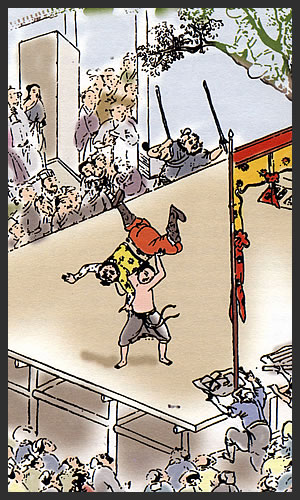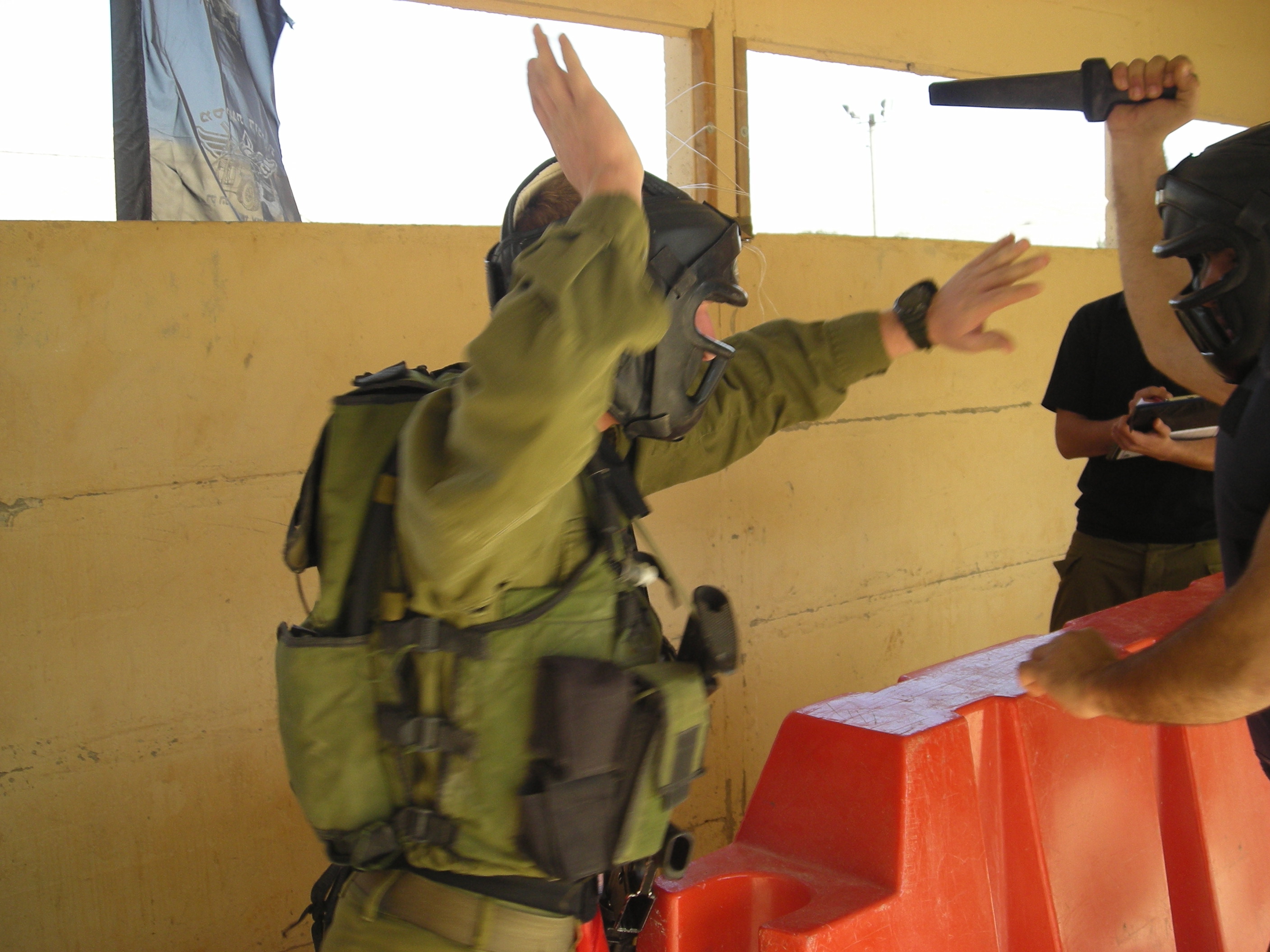|
Judo
is an unarmed modern Japanese martial art, Olympic sport (since 1964), and the most prominent form of jacket wrestling competed internationally.『日本大百科全書』電子版【柔道】(CD-ROM version of Encyclopedia Nipponica, "Judo"). Judo was created in 1882 by Kanō Jigorō () as an eclectic martial art, distinguishing itself from its predecessors (primarily Tenjin Shinyo-ryu jujutsu and Kitō-ryū jujutsu) due to an emphasis on " randori" (, lit. 'free sparring') instead of "kata" (pre-arranged forms) alongside its removal of striking and weapon training elements. Judo rose to prominence for its dominance over established jujutsu schools in tournaments hosted by the Tokyo Metropolitan Police Department (警視庁武術大会, ''Keishicho Bujutsu Taikai''), resulting in its adoption as the department's primary martial art. A judo practitioner is called a , and the judo uniform is called . The objective of competitive judo is to throw an opponent, immobilize them ... [...More Info...] [...Related Items...] OR: [Wikipedia] [Google] [Baidu] |
List Of Judoka
This is a list of highly notable judoka (judo practitioners). Founder * Jigorō Kanō (Japan, 1860–1938) founded judo, and established the Kōdōkan in 1882. Judo was the first Japanese martial art to gain widespread international recognition, and the first to become an official Olympic sport. Kanō was also a pioneer of international sports. Accomplishments included being the first Asian member of the International Olympic Committee (IOC). His official honours and decorations included the First Order of Merit and Grand Order of the Rising Sun and the Third Imperial Degree. He was inducted to the IJF Hall of Fame on 14 May 1999. The ''IJF Hall of Fame'' was established in 1999. Only three people have ever been inducted into it. Highest grades Only fifteen people have been promoted to 10th dan by the Kōdōkan. Twelve were promoted between 1935 and 1984. The other three were promoted together on 8 January 2006. However as of October 2022-end, all three of the 2006 promot ... [...More Info...] [...Related Items...] OR: [Wikipedia] [Google] [Baidu] |
Kanō Jigorō
was a Japanese educator, athlete, and the founder of Judo. Along with Ju-Jutsu, Judo was one of the first Japanese martial arts to gain widespread international recognition, and the first to become an official Olympic sport. Pedagogical innovations attributed to Kanō include the use of black and white belts, and the introduction of dan ranking to show the relative ranking among members of a martial art style. Well-known mottoes attributed to Kanō include "maximum efficiency with minimum effort" ( ''seiryoku zen'yō'') and "mutual welfare and benefit" ( ''jita kyōei''). In his professional life, Kanō was an educator. Important postings included serving as director of primary education for the from 1898 to 1901, and as president of Tokyo Higher Normal School from 1900 until 1920.Strictly speaking, the name was Tokyo Normal School from 1901 until 1903, and Tokyo Higher Normal School from 1903 to 1924. Tokyo Higher Normal School is today viewed as an ancestor of the Institu ... [...More Info...] [...Related Items...] OR: [Wikipedia] [Google] [Baidu] |
Jujutsu
Jujutsu ( ; ja, link=no, 柔術 , ), also known as jiu-jitsu and ju-jitsu, is a family of Japanese martial arts and a system of close combat (unarmed or with a minor weapon) that can be used in a defensive or offensive manner to kill or subdue one or more weaponless or armed and armored opponents. Jiu-jitsu dates back to the 1530s and was coined by Hisamori Tenenouchi when he officially established the first jiu-jitsu school in Japan. This form of martial arts uses few or no weapons at all and includes strikes, throws, holds, and paralyzing attacks against the enemy. Jujutsu developed from the warrior class around the 17th century in Japan. It was designed to supplement the swordsmanship of a warrior during combat. A subset of techniques from certain styles of jujutsu were used to develop many modern martial arts and combat sports, such as judo, aikido, sambo, ARB, Brazilian jiu-jitsu, and mixed martial arts. The official date of foundation of Jiu Jitsu is 1530. Cha ... [...More Info...] [...Related Items...] OR: [Wikipedia] [Google] [Baidu] |
Mixed Martial Arts
Mixed martial arts (MMA), sometimes referred to as cage fighting, no holds barred (NHB), and ultimate fighting, and originally referred to as Vale Tudo is a full-contact combat sport based on strike (attack), striking, grappling and ground fighting, incorporating techniques from various combat sports from around the world. The first documented use of the term ''mixed martial arts'' was in a review of UFC 1 by television critic Howard Rosenberg in 1993. The question of who actually coined the term is subject to debate. During the early 20th century, various interstylistic contests took place throughout Japan and in the countries of the Four Asian Tigers. In Brazil, there was the sport of Vale Tudo, in which The Gracie family was known to promote Vale Tudo matches as a way to promote their own Brazilian jiu-jitsu style. A precursor to modern MMA was the 1976 Muhammad Ali vs. Antonio Inoki, Ali vs. Inoki exhibition bout (which ended in a draw after 15 rounds), fought between bo ... [...More Info...] [...Related Items...] OR: [Wikipedia] [Google] [Baidu] |
Kosen Judo
is a variation of the Kodokan judo competitive ruleset that was developed and flourished at the () technical colleges in Japan in the first half of the twentieth century. Kosen judo's rules allow for greater emphasis of than typically takes place in competitive judo and it is sometimes regarded as a distinct style of judo.Green and Svinth 2003, p282 Currently the term "kosen judo" is frequently used to refer to the competition ruleset associated with it that allows for extended ''ne-waza''. Such competition rules are still used in the competitions held annually between the seven former Imperial universities. Similarly, there has been a resurgence in interest in Kosen judo in recent years due to its similarities with Brazilian jiu jitsu. History is an abbreviation of , literally 'higher speciality school', and refers to the colleges of technology in Japan that cater for students from age 15 to 20. The kosen schools started holding judo competitions in 1898, four years a ... [...More Info...] [...Related Items...] OR: [Wikipedia] [Google] [Baidu] |
Brazilian Jiu-jitsu
Brazilian jiu-jitsu (BJJ; pt, jiu-jitsu brasileiro ) is a self-defence martial art and combat sport based on grappling, ground fighting ( ne-waza) and submission holds. BJJ focuses on the skill of taking an opponent to the ground, controlling one's opponent, gaining a dominant position, and using a number of techniques to force them into submission via joint locks or chokeholds. Brazilian jiu-jitsu was initially developed in 1926 by Brazilian brothers Carlos, Oswaldo, Gastão Jr., George, and Hélio Gracie, after Carlos was taught jiu-jitsu by a travelling Japanese judoka, Mitsuyo Maeda who himself mastered his ground fighting while interacting with Taro Miyake (Tanabe student), Sadakazu Uyenishi (Handa, Tanabe) and Yukio Tani (Tenjin Shinyo-ryu) and catch wrestlers in Europe. Later on, the Gracie family developed their own self-defense system, and published ''Gracie Jiu-Jitsu''. BJJ eventually came to be its own defined combat sport through the innovations, pra ... [...More Info...] [...Related Items...] OR: [Wikipedia] [Google] [Baidu] |
Kyuzo Mifune
has been categorized as one of the greatest exponents of the art of judo after the founder, Kanō Jigorō. He is considered by many to be the greatest judo technician ever, after Kanō. Early life Mifune was born on April 21, 1883, in Kuji, Iwate, Kuji City, Iwate Prefecture, on Honshū, Honshū Island in Japan, a year after the Kodokan was founded.International Budo Institute: Kyuzo Mifune (''c.'' 2005). Retrieved on June 18, 2010.Noha, R. (''c.'' 2005) Kyuzo Mifune, Master of Judo Retrieved on June 11, 2010. [...More Info...] [...Related Items...] OR: [Wikipedia] [Google] [Baidu] |
Tenjin Shin'yō-ryū
, meaning "Divine True Willow School", can be classified as a traditional school ('' koryū'') of jujutsu. It was founded by in the 1830s. Its syllabus comprises ''atemi-waza'' (striking techniques), ''nage-waza'' (throwing techniques), ''torae-waza'' (immobilization methods) and ''shime-waza'' (choking techniques). Once a very popular jujutsu system in Japan, among the famous students who studied the art were Kanō Jigorō, whose modern art of judo was greatly inspired by the Tenjin Shin'yō-ryū and Kitō-ryū. Description Essentially, Tenjin Shinyo-ryu is the amalgamation of two separate systems of jujutsu: the Yōshin-ryū and Shin no Shinto-ryu. The distinctive feature of this particular school is the use of ''atemi'' or strikes to disrupt the balance of the opponent as well as a more flexible and flowing movement of the body than seen in some older schools of jujutsu. The older schools employ somewhat larger and slower movements to mimic the use of armour in the battl ... [...More Info...] [...Related Items...] OR: [Wikipedia] [Google] [Baidu] |
Grappling
Grappling, in hand-to-hand combat, describes sports that consist of gripping or seizing the opponent. Grappling is used at close range to gain a physical advantage over an opponent, either by imposing a position or causing injury. Grappling is a broad term that encompasses many disciplines. These various martial arts can be practiced both as combat sports and for self-defense. Grappling contests often involve takedowns and ground control, and may end when a contestant concedes defeat, also known as a submission or tap out. Grappling most commonly does not include striking or the use of weapons. However, some fighting styles or martial arts known especially for their grappling techniques teach tactics that include strikes and weapons either alongside grappling or combined with it. Grappling appeared in the 1950s. Types of technique Grappling techniques can be broadly subdivided into clinch fighting; takedowns and throws; submission holds and pinning or controll ... [...More Info...] [...Related Items...] OR: [Wikipedia] [Google] [Baidu] |
Krav Maga
Krav Maga ( ; , ; ) is an Israeli martial art. Developed for the Israel Defense Forces (IDF), it is derived from a combination of techniques used in aikido, judo, karate, boxing, and wrestling. It is known for its focus on real-world situations and its extreme efficiency. Hungarian-born Israeli martial artist Imi Lichtenfeld, who made use of his training as a boxer and wrestler to defend Jews in Bratislava against fascist groups in the mid-to-late 1930s, developed Krav Maga through his experiences in street fighting. After his immigration to Mandatory Palestine in the late 1940s, he began to provide lessons on combat training to Jewish paramilitary groups that would later form the IDF during the Israeli War of Independence. From the outset, the original concept of Krav Maga was to take the most effective and practical techniques of other fighting styles (originally European boxing, wrestling, and street fighting) and make them rapidly teachable to conscripted soldiers.< ... [...More Info...] [...Related Items...] OR: [Wikipedia] [Google] [Baidu] |
SAMBO
, aka = Sombo (in English-speaking countries) , focus = Hybrid , country = Soviet Union , pioneers = Viktor Spiridonov, Vasili Oshchepkov, Anatoly Kharlampiev , famous_pract = List of Practitioners , olympic = No, but IOC recognized , website = , module=, ancestor arts=Catch Wrestling, Judo, Kickboxing, Japanese Jiu Jitsu, Boxing Sambo (russian: са́мбо, ) is a Russian martial art with Soviet origins, an internationally practiced combat sport, and a recognized style of amateur wrestling included by UWW in the World Wrestling Championships along with Greco-Roman wrestling and freestyle wrestling. Etymology It originated in the Russian SFSR in the Soviet Union. The word ''sambo'' is an acronym of (russian: самозащита без оружия), which literally translates to 'self-defence without weapons'. Origins Sambo is relatively modern since its development began in the early 1920s by the Soviet NKV ... [...More Info...] [...Related Items...] OR: [Wikipedia] [Google] [Baidu] |

.jpg)






.jpg)